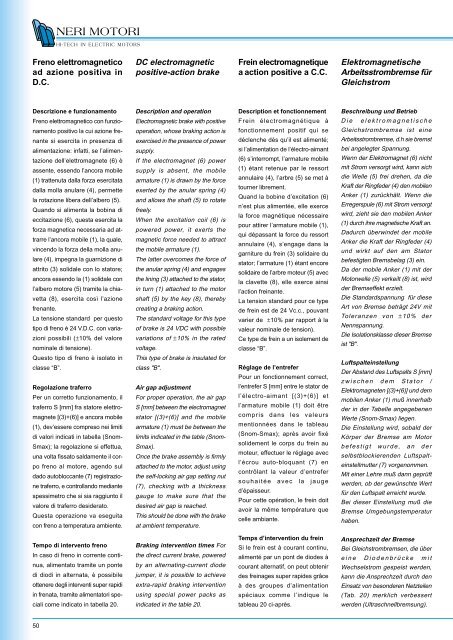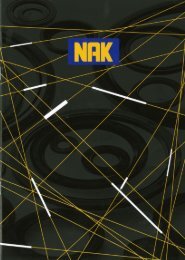NR cat. gen. 002/003 - NBC Group Ltd
NR cat. gen. 002/003 - NBC Group Ltd
NR cat. gen. 002/003 - NBC Group Ltd
Create successful ePaper yourself
Turn your PDF publications into a flip-book with our unique Google optimized e-Paper software.
50<br />
NERI MOTORI<br />
HI-TECH IN ELECTRIC MOTORS<br />
Freno elettromagnetico<br />
ad azione positiva in<br />
D.C.<br />
Descrizione e funzionamento<br />
Freno elettromagnetico con funzionamento<br />
positivo la cui azione frenante<br />
si esercita in presenza di<br />
alimentazione: infatti, se l’alimentazione<br />
dell’elettromagnete (6) è<br />
assente, essendo l’ancora mobile<br />
(1) trattenuta dalla forza esercitata<br />
dalla molla anulare (4), permette<br />
la rotazione libera dell’albero (5).<br />
Quando si alimenta la bobina di<br />
eccitazione (6), questa esercita la<br />
forza magnetica necessaria ad attrarre<br />
l’ancora mobile (1), la quale,<br />
vincendo la forza della molla anulare<br />
(4), impegna la guarnizione di<br />
attrito (3) solidale con lo statore;<br />
ancora essendo la (1) solidale con<br />
l’albero motore (5) tramite la chiavetta<br />
(8), esercita così l’azione<br />
frenante.<br />
La tensione standard per questo<br />
tipo di freno è 24 V.D.C. con variazioni<br />
possibili (±10% del valore<br />
nominale di tensione).<br />
Questo tipo di freno è isolato in<br />
classe “B”.<br />
Regolazione traferro<br />
Per un corretto funzionamento, il<br />
traferro S [mm] fra statore elettromagnete<br />
[(3)+(6)] e ancora mobile<br />
(1), dev’essere compreso nei limiti<br />
di valori indi<strong>cat</strong>i in tabella (Snom-<br />
Smax); la regolazione si effettua,<br />
una volta fissato saldamente il corpo<br />
freno al motore, a<strong>gen</strong>do sul<br />
dado autobloccante (7) registrazione<br />
traferro, e controllando mediante<br />
spessimetro che si sia raggiunto il<br />
valore di traferro desiderato.<br />
Questa operazione va eseguita<br />
con freno a temperatura ambiente.<br />
Tempo di intervento freno<br />
In caso di freno in corrente continua,<br />
alimentato tramite un ponte<br />
di diodi in alternata, è possibile<br />
ottenere degli interventi super rapidi<br />
in frenata, tramite alimentatori speciali<br />
come indi<strong>cat</strong>o in tabella 20.<br />
DC electromagnetic<br />
positive-action brake<br />
Description and operation<br />
Electromagnetic brake with positive<br />
operation, whose braking action is<br />
exercised in the presence of power<br />
supply.<br />
If the electromagnet (6) power<br />
supply is absent, the mobile<br />
armature (1) is drawn by the force<br />
exerted by the anular spring (4)<br />
and allows the shaft (5) to rotate<br />
freely.<br />
When the excitation coil (6) is<br />
powered power, it exerts the<br />
magnetic force needed to attract<br />
the mobile armature (1).<br />
The latter overcomes the force of<br />
the anular spring (4) and engages<br />
the lining (3) attached to the stator,<br />
in turn (1) attached to the motor<br />
shaft (5) by the key (8), thereby<br />
creating a braking action.<br />
The standard voltage for this type<br />
of brake is 24 VDC with possible<br />
variations of ±10% in the rated<br />
voltage.<br />
This type of brake is insulated for<br />
class "B".<br />
Air gap adjustment<br />
For proper operation, the air gap<br />
S [mm] between the electromagnet<br />
stator [(3)+(6)] and the mobile<br />
armature (1) must be between the<br />
limits indi<strong>cat</strong>ed in the table (Snom-<br />
Smax).<br />
Once the brake assembly is firmly<br />
attached to the motor, adjust using<br />
the self-locking air gap setting nut<br />
(7), checking with a thickness<br />
gauge to make sure that the<br />
desired air gap is reached.<br />
This should be done with the brake<br />
at ambient temperature.<br />
Braking intervention times For<br />
the direct current brake, powered<br />
by an alternating-current diode<br />
jumper, it is possible to achieve<br />
extra-rapid braking intervention<br />
using special power packs as<br />
indi<strong>cat</strong>ed in the table 20.<br />
Frein electromagnetique<br />
a action positive a C.C.<br />
Description et fonctionnement<br />
Frein électromagnétique à<br />
fonctionnement positif qui se<br />
déclenche dès qu’il est alimenté;<br />
si l’alimentation de l’électro-aimant<br />
(6) s’interrompt, l’armature mobile<br />
(1) étant retenue par le ressort<br />
annulaire (4), l’arbre (5) se met à<br />
tourner librement.<br />
Quand la bobine d’excitation (6)<br />
n’est plus alimentée, elle exerce<br />
la force magnétique nécessaire<br />
pour attirer l’armature mobile (1),<br />
qui dépassant la force du ressort<br />
annulaire (4), s’engage dans la<br />
garniture du frein (3) solidaire du<br />
stator; l’armature (1) étant encore<br />
solidaire de l’arbre moteur (5) avec<br />
la clavette (8), elle exerce ainsi<br />
l’action freinante.<br />
La tension standard pour ce type<br />
de frein est de 24 Vc.c., pouvant<br />
varier de ±10% par rapport à la<br />
valeur nominale de tension).<br />
Ce type de frein a un isolement de<br />
classe “B”.<br />
Réglage de l’entrefer<br />
Pour un fonctionnement correct,<br />
l’entrefer S [mm] entre le stator de<br />
l’électro-aimant [(3)+(6)] et<br />
l’armature mobile (1) doit être<br />
compris dans les valeurs<br />
mentionnées dans le tableau<br />
(Snom-Smax); après avoir fixé<br />
solidement le corps du frein au<br />
moteur, effectuer le réglage avec<br />
l’écrou auto-bloquant (7) en<br />
contrôlant la valeur d’entrefer<br />
souhaitée avec la jauge<br />
d’épaisseur.<br />
Pour cette opération, le frein doit<br />
avoir la même température que<br />
celle ambiante.<br />
Temps d’intervention du frein<br />
Si le frein est à courant continu,<br />
alimenté par un pont de diodes à<br />
courant alternatif, on peut obtenir<br />
des freinages super rapides grâce<br />
à des groupes d’alimentation<br />
spéciaux comme l’indique le<br />
tableau 20 ci-après.<br />
Elektromagnetische<br />
Arbeitsstrombremse für<br />
Gleichstrom<br />
Beschreibung und Betrieb<br />
Die elektromagnetische<br />
Gleichstrombremse ist eine<br />
Arbeitsstrombremse, d.h sie bremst<br />
bei angelegter Spannung.<br />
Wenn der Elektromagnet (6) nicht<br />
mit Strom versorgt wird, kann sich<br />
die Welle (5) frei drehen, da die<br />
Kraft der Ringfeder (4) den mobilen<br />
Anker (1) zurückhält. Wenn die<br />
Erregerspule (6) mit Strom versorgt<br />
wird, zieht sie den mobilen Anker<br />
(1) durch ihre magnetische Kraft an.<br />
Dadurch überwindet der mobile<br />
Anker die Kraft der Ringfeder (4)<br />
und wirkt auf den am Stator<br />
befestigten Bremsbelag (3) ein.<br />
Da der mobile Anker (1) mit der<br />
Motorwelle (5) verkeilt (8) ist, wird<br />
der Bremseffekt erzielt.<br />
Die Standardspannung für diese<br />
Art von Bremse beträgt 24V mit<br />
Toleranzen von ±10% der<br />
Nennspannung.<br />
Die Isolationsklasse dieser Bremse<br />
ist "B".<br />
Luftspalteinstellung<br />
Der Abstand des Luftspalts S [mm]<br />
zwischen dem Stator /<br />
Elektromagneten [(3)+(6)] und dem<br />
mobilen Anker (1) muß innerhalb<br />
der in der Tabelle angegebenen<br />
Werte (Snom-Smax) lie<strong>gen</strong>.<br />
Die Einstellung wird, sobald der<br />
Körper der Bremse am Motor<br />
befestigt wurde, an der<br />
selbstblockierenden Luftspalteinstellmutter<br />
(7) vor<strong>gen</strong>ommen.<br />
Mit einer Lehre muß dann geprüft<br />
werden, ob der gewünschte Wert<br />
für den Luftspalt erreicht wurde.<br />
Bei dieser Einstellung muß die<br />
Bremse Umgebungstemperatur<br />
haben.<br />
Ansprechzeit der Bremse<br />
Bei Gleichstrombremsen, die über<br />
eine Diodenbrücke mit<br />
Wechselstrom gespeist werden,<br />
kann die Ansprechzeit durch den<br />
Einsatz von besonderen Netzteilen<br />
(Tab. 20) merklich verbessert<br />
werden (Ultraschnellbremsung).



